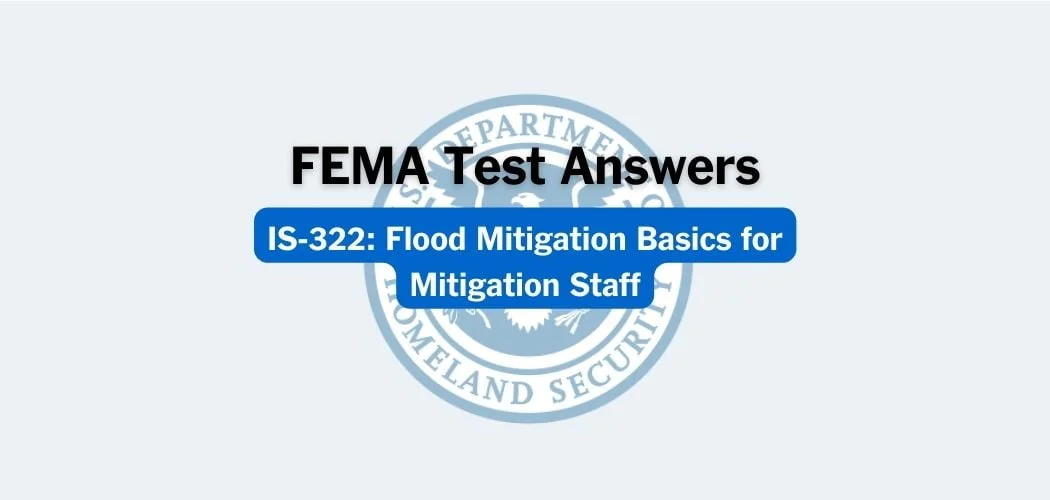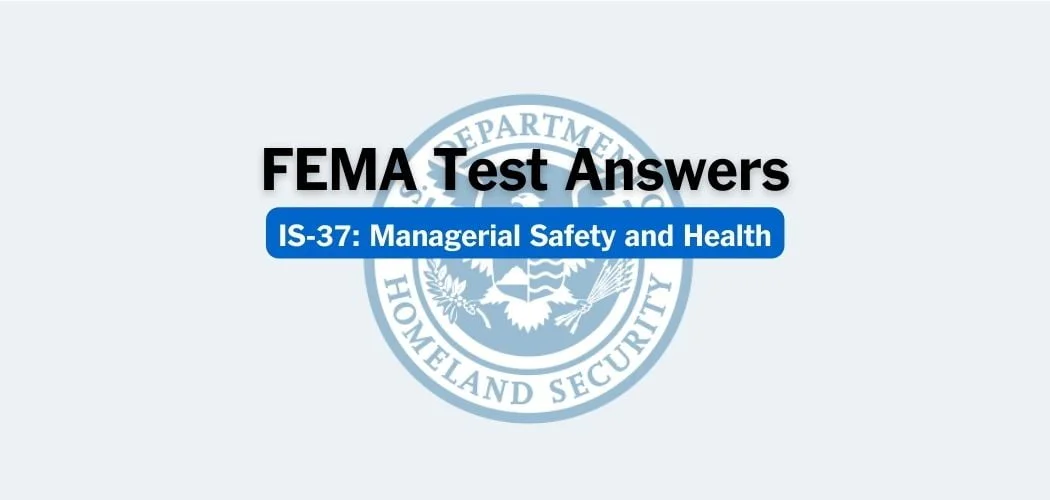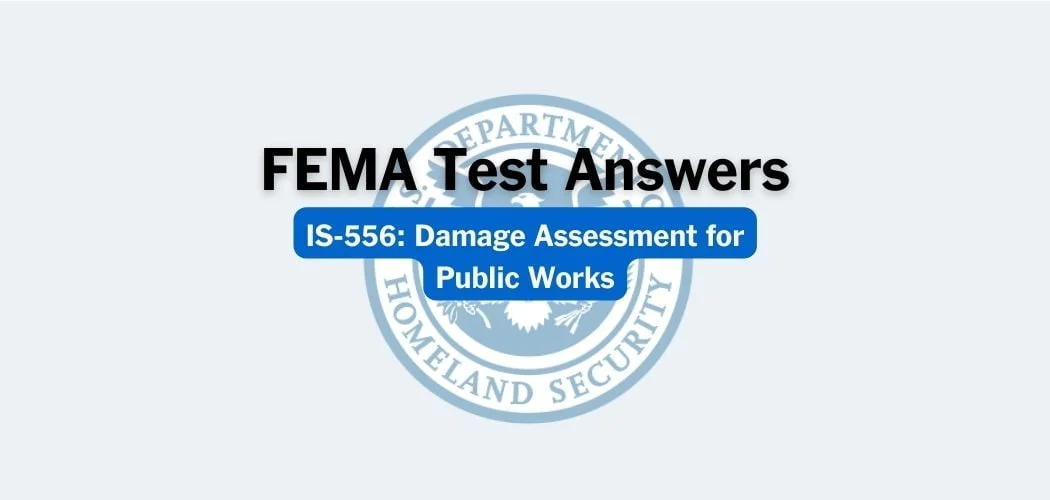Overview: The FEMA IS-2000 course was published on 3/26/2018 to provide an overview of the National Preparedness Goal and the National Preparedness System. The foundation is the National Preparedness Goal which identifies the Nation’s core capabilities required for executing the five mission areas of Prevention, Protection, Mitigation, Response, and Recovery.
Primary audience: IS-2000 is for individuals with emergency management responsibilities including prevention, protection, mitigation, response, and recovery. The goal is to familiarize participants with the National Preparedness Goal and the six main components of the National Preparedness System.
FEMA IS-2000 test answers
Each time this test is loaded, you will receive a unique set of questions and answers. The test questions are scrambled to protect the integrity of the exam.
Question 1. Which Prevention core capability is implemented to identify, discover, or locate threats and/or hazards through active and passive surveillance and search procedures?
A. Screening, Search, and Detection✅
B. Interdiction and Disruption
C. Intelligence and Information Sharing
D. Forensics and Attribution
Question 2. The Estimating Capability Requirements component of the National Preparedness System does NOT involve:
A. Obtaining funds to build new capabilities.✅
B. Identifying capabilities that should be sustained.
C. Assessing current capability levels.
D. Determining the capabilities needed to address the identified risks.
Question 3. Presidential Policy Directive 8 is organized around five elements. One of these elements is an ongoing national effort to build and sustain preparedness.
A. TRUE✅
B. FALSE
Question 4. Which component of the National Preparedness System involves collecting information regarding threats and hazards, including the projected consequences or impacts?
A. Planning to Deliver Capabilities
B. Building and Sustaining Capabilities
C. Validating Capabilities
D. Reviewing and Updating
E. Estimating Capability Requirements
F. Identifying and Assessing Risk✅
Question 5. The Building and Sustaining Capabilities component of the National Preparedness System involves providing training and conducting exercises.
A. TRUE✅
B. FALSE
Question 6. The National Preparedness Goal includes five mission areas. Which mission area includes the capabilities necessary to secure the homeland against acts of terrorism and manmade or natural disasters?
A. Response
B. Mitigation
C. Recovery
D. Protection✅
E. Prevention
Question 7. The National Preparedness Goal includes five mission areas. Which mission area includes the capabilities necessary to assist communities affected by an incident to recover effectively?
A. Response
B. Mitigation
C. Recovery✅
D. Protection
E. Prevention
Question 8. The way we can measure, describe, and implement our security and resilience is through core capabilities.
A. TRUE✅
B. FALSE
Question 9. Which of the three core capabilities common to all mission areas is described as the delivery of coordinated, prompt, reliable, and actionable information to the whole community through the use of clear, consistent, accessible, and culturally and linguistically appropriate methods to effectively relay information regarding any threat or hazard, as well as the actions being taken and the assistance being made available, as appropriate?
A. Operational Coordination
B. Public Information and Warning✅
C. Planning
Question 10. Which Recovery core capability is implemented to return economic and business activities (including food and agriculture) to a healthy state and develop new business and employment opportunities that result in an economically viable community?
A. Natural and Cultural Resources
B. Housing
C. Health and Social Services
D. Economic Recovery✅
Question 11. The National Preparedness Goal includes five mission areas. Which mission area includes the capabilities necessary to avoid, prevent, or stop a threatened or actual act of terrorism?
A. Response
B. Mitigation
C. Recovery
D. Protection
E. Prevention✅
Question 12. Which Mitigation core capability is implemented to enable the recognition, understanding, communication of, and planning for risk and empower individuals and communities to make informed risk management decisions necessary to adapt to, withstand, and quickly recover from future incidents?
A. Threats and Hazards Identification
B. Risk and Disaster Resilience Assessment
C. Long-Term Vulnerability Reduction✅
D. Community Resilience
Question 13. On a recurring basis, preparedness partners at all levels should review and update capabilities, resources, and plans.
A. TRUE✅
B. FALSE
Question 14. The National Preparedness Goal includes five mission areas. Which mission area includes the capabilities necessary to save lives, protect property and the environment, and meet basic human needs after an incident has occurred?
A. Response✅
B. Mitigation
C. Recovery
D. Protection
E. Prevention
Question 15. Which Response core capability is implemented to provide life-sustaining and human services to the affected population to include hydration, feeding, sheltering, temporary housing, evacuee support, reunification, and distribution of emergency supplies?
A. Situational Assessment
B. Mass Care Services✅
C. Infrastructure Systems
D. Critical Transportation
Question 16. Which of these is NOT one of the three cross-cutting core capabilities?
A. Operational Coordination
B. Mass Care Services✅
C. Public Information and Warning
D. Planning
Question 17. Which Recovery core capability implements housing solutions that effectively support the needs of the whole community and contribute to its sustainability and resilience?
A. Natural and Cultural Resources
B. Housing✅
C. Health and Social Services
D. Economic Recovery
Question 18. Which of the three cross-cutting core capabilities is described as a systematic process engaging the whole community as appropriate in the development of executable strategic, operational, and/or tactical-level approaches to meet defined objectives?
A. Operational Coordination
B. Public Information and Warning
C. Planning✅
Question 19. Which of these refers to those capabilities necessary to save lives, protect property and the environment, and meet basic human needs after an incident has occurred?
A. Recovery
B. Response✅
C. Protection
D. Prevention
Question 20. Which Protection core capability is the implementation and maintenance of risk-informed countermeasures, and policies protecting people, borders, structures, materials, products, and systems associated with key operational activities and critical infrastructure sectors?
A. Physical Protective Measures✅
B. Risk Management for Protection Programs and Activities
C. Cybersecurity
D. Access Control and Identity Verification
Question 21. Which of these refers to those capabilities necessary to reduce loss of life and property by lessening the impact of disasters? The capabilities include, but are not limited to, community-wide risk reduction projects, efforts to improve the resilience of critical infrastructure and key resource lifelines, risk reduction for specific vulnerabilities from natural hazards or acts of terrorism, and initiatives to reduce future risks after a disaster has occurred.
A. Recovery
B. Mitigation✅
C. Protection
D. Prevention
Question 22. Which of these refers to the ability to adapt to changing conditions and withstand and rapidly recover from disruption due to emergencies?
A. Mitigation
B. Protection
C. Resilience✅
D. Security
Question 23. The National Preparedness Goal recognizes that only Federal agencies can contribute to and benefit from national preparedness efforts.
A. TRUE
B. FALSE✅
Question 24. Which of these is NOT a goal of Presidential Policy Directive 8?
A. Implement a comprehensive campaign to build and sustain national preparedness
B. Enforce preparedness plans through a series of audits on whole community members✅
C. Develop a series of frameworks and plans related to reaching the national preparedness goal
D. Develop a national preparedness goal with the help of the whole community
Question 25. The National Preparedness Goal
A. Identifies a shared understanding of the roles and responsibilities of the Federal government and the whole community.
B. Is the instrument the Nation will employ to build, sustain, and deliver core capabilities.
C. Sets the vision for preparedness nationwide and identifies the core capabilities necessary to achieve that vision.✅
D. Outlines the approach, resources, and tools for each Framework.
Question 26. The National Preparedness System outlines the approach, resources, and tools to aid the whole community in its preparedness activities to achieve the National Preparedness Goal.
A. TRUE✅
B. FALSE
![[FEMA Test Answers] IS-8.A: Building for the Earthquakes of Tomorrow - Test Pinoy](https://testpinoy.com/wp-content/uploads/2021/11/fema-is-8a.jpg.webp)


